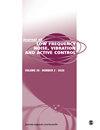Frequency domain-based analytical framework for seismic performance of viscously damped outrigger systems based on continuous Timoshenko beam theory
IF 2.4
4区 工程技术
Q1 ACOUSTICS
Journal of Low Frequency Noise Vibration and Active Control
Pub Date : 2023-03-29
DOI:10.1177/14613484231166523
引用次数: 3
Abstract
This paper proposes a frequency domain-based analytical framework for seismic performance of viscously damped outrigger systems. Based on a core–outrigger–damper–column simplified model, the global dynamic stiffness matrix is assembled from the core modeled as a Timoshenko beam, damped outriggers as complex rotational stiffness comprising outriggers, dampers, and perimeter columns, and inherent damping using Leung’s theory and modal damping construction. A general numerical method combining Wittrick-Williams algorithm and Newtonian iteration is developed to study the dynamic characteristic of such systems with multiple damped outriggers. The fast Fourier transformation (FFT) and the inverse Fourier transformation (IFFT) are then integrated with the principle of potential energy to obtain the equivalent nodal force and thus the time history response by transformations between time and frequency domains. Finally, the stochastic analysis is conducted via the transfer function resulting from the global stiffness matrix with the stochastic seismic excitation following Kanai-Tajimi spectrum. The proposed approach is verified by comparison with the finite element method through a case study of a tall building implemented with viscously damped outriggers. This study shows that the proposed analytical framework could serve as a powerful tool for evaluating the performance of viscously damped outrigger systems.基于连续Timoshenko梁理论的粘滞支臂结构抗震性能频域分析框架
本文提出了一种基于频域的粘滞支臂结构抗震性能分析框架。基于核心-外伸器-阻尼器-柱简化模型,将核心建模为Timoshenko梁,阻尼外伸器作为包括外伸器、阻尼器和周长柱的复杂旋转刚度,以及使用Leung理论和模态阻尼结构的固有阻尼,组装了全局动态刚度矩阵。将Wittrick-Williams算法与牛顿迭代相结合,提出了一种研究多阻尼外伸臂系统动态特性的通用数值方法。然后将快速傅立叶变换(FFT)和反傅立叶变换(IFFT)与势能原理相结合,通过时频域变换得到等效节点力,从而得到时程响应。最后,在Kanai-Tajimi谱随机激励下,通过由整体刚度矩阵得到的传递函数进行随机分析。以某高层建筑为例,通过与有限元法的比较,验证了该方法的有效性。该研究表明,所提出的分析框架可以作为评估粘滞阻尼支腿系统性能的有力工具。
本文章由计算机程序翻译,如有差异,请以英文原文为准。
求助全文
约1分钟内获得全文
求助全文
来源期刊

Journal of Low Frequency Noise Vibration and Active Control
Engineering-Mechanical Engineering
CiteScore
4.90
自引率
4.30%
发文量
98
审稿时长
15 weeks
期刊介绍:
Journal of Low Frequency Noise, Vibration & Active Control is a peer-reviewed, open access journal, bringing together material which otherwise would be scattered. The journal is the cornerstone of the creation of a unified corpus of knowledge on the subject.
 求助内容:
求助内容: 应助结果提醒方式:
应助结果提醒方式:


